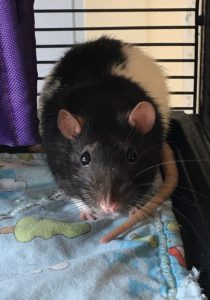 {Mandatory preamble: As with all of my blog posts, the views espoused herein are mine alone and should be construed as neither shared nor endorsed by any organization with which I have an affiliation.}
{Mandatory preamble: As with all of my blog posts, the views espoused herein are mine alone and should be construed as neither shared nor endorsed by any organization with which I have an affiliation.}
This post is about perseverance in the face of rejection, which, as an academic physician, is something I am tasked with essentially in perpetuity. Whether it’s grants or manuscripts or awards, we academics know that nine times out of ten, we’ll be met with a minimum “no thanks”, and in more bountiful times, a “no thanks” that is accompanied by a literal trashing of our work. And since our Simon Cowells get to remain anonymous, not a single punch is pulled. Ever. Early on in our careers, we become well acquainted with the application-rejection cycle, so well so that despite our horrible odds, we never truly give up, which I admit is a bit pathetic. Even when we lack success, we exercise the moxie, temerity, and bootstraps required to just slam right back into that brick wall head first. It’s a good life.
It may come as no surprise to those of you who know me that the child I spawned is a planner. As such, about 6 months before his 8th birthday, he began to think about exactly which kind of pet – an animal was a foregone conclusion, after all – he would add to his birthday list. Our goldfish had perished in an unfortunate filter ‘incident’, and our experiment with snails, while of reasonable longevity relative to a mollusc’s lifespan, had ended some months prior when the last of the petrified little snail carcasses had been discovered on the floor underneath their tank. He knew better than to ask for a dog or a cat, what with our travel schedule, and the exotic invertebrate, amphibian, and reptile taxonomies lacked the cuddly feel he was seeking. Thus was born the idea of a hamster. As a child of the 70s, I was well familiar with the idiosyncrasies of the hamster set. Hermie and Ralph were my first childhood hamsters, and let me tell you something, Ralph was a real A-hole. Picture the rodent embodiment of unmitigated fury, and that was Ralph. Who could explain why he was so pissed off? I don’t think he was rabid, given that I survived at least two-dozen puncture wounds courtesy of his incisors over the 18-months of our co-habitation in my parents’ home…… Hermie, on the other hand, was the polar opposite – gentle, sweet, affectionate – and offered at least a mild antidote to Ralph’s sour disposition. Despite bearing the scars of his rodent gnash holes on my pediatric hands, I still held what I consider to be a very moving garden burial service for Ralph after discovering his stone cold little corpse in his cage one day. Hermie outlived Ralph by a good many months, which he spent gleefully out and about in his hamster ball or running on his wheel. His departure from this Earth was similarly sudden and foreshadowed by nary a sign of illness. I laid him to rest alongside Ralph in the rock garden, after gathering the family for a ceremony befitting such a kind creature, and then I moved on from that loss as well.
When my son declared a hamster to be his animal companion of choice, then, I was confident he could handle the joys and challenges of such a relationship. Now unlike in the 70s and 80s, though, we were going to do the right thing and adopt a surplus hamster from a no-kill shelter of course. Alas, such shelters don’t actually stock all the paraphernalia required for a hamster start-up, so off we trotted to the local pet store to investigate options. Give a kid five seconds in a pet store and they’ll fill a cart. At checkout, a slightly older kid employed by the store reviewed our intended purchases and inquired around the intended recipient. Upon hearing the obligatory ‘hamster’ response from my son, his brow furrowed ever so slightly and a fleeting look crept across eyes that betrayed a deep, focused, and scholarly knowledge of the Rodentia. “A hamster, huh?” he said, as he scanned our items, my distracted mind already four items down on the daily to-do list. What he said next snapped me right back to attention, my panicking brain inelegantly righting itself on a flailing axis as it slowly and silently repeated his question: “Have you ever thought about a rat?” I froze, a cold sweat materializing on a thorax that wasn’t breathing while I awaited that eternal second to pass during which it became obvious that my son had, indeed, heard the question. “A rat!” he replied, “why would we get a rat!?!” Absolute gold star to employee-of-the-month checkout teenager who most comprehensively and enthusiastically obliged that question! Rats, didn’t we know, are more intelligent, more friendly, more affectionate, and less nippy than hamsters. And bonus! They also live longer. My son was sold. And once her son is sold, so too is the guilt-ridden academic doctor mom who cannot, under any circumstances, shoulder the weight of a ruined birthday. And so a rat it was! Or rather, two rats. Since they are so intelligent and sociable, it would be irresponsible of us to adopt just one. What we needed to find was a bonded pair. My cerebral cortices remained in the pet store while my hindbrain conducted a dazed body along the sidewalk with a chattering son, skipping along and elated that we would now be adopting double the rodent biomass to which I had previously committed. That teenager was a friggin’ rat encyclopedia, and I hadn’t studied a bit. I was outgunned. I hadn’t stood a chance.
Over the next week, I collected myself, resigned to the possibility that I would welcome into our home not one but two of the most reviled and notorious creatures on God’s green Earth. As a philosophical vegan, I challenged my own internal biases and began to take pride in my open-mindedness and that of my son. Could I be the bigger benevolent person here and open my heart and home to the Bubonic plague?? The silver lining, I thought, was that we wouldn’t have any trouble finding a couple of surplus rats at an animal shelter! Boy, I could not have been more wrong.
Our first stop after the ill-fated pet store, was our local humane society, the website of which we had already scoured for potential adoptees. Sandy* was featured amidst photos of chinchillas and a set of gerbils. Most importantly, he was listed as “available”. In we breezed to the shelter, and conveyed ourselves to the “small animal” section of what was truly a cacophonous and cavernous building right downtown. We spotted him immediately. My Sandy was large! “Wow!” my son said, “that’s him!”. Not only was Sandy over a foot long, he was also a tad corpulent, which I attributed to the sedentariness and overfeeding of what was, I would later deduce, an unusually protracted “bite quarantine”. Sandy, we learned, had a low bite threshold, which meant that he couldn’t be handled until he was through his quarantine, which wasn’t immediately clear would end during his lifetime. Through the bullet-proof plexiglass of his enclosure, Sandy sat there peering at me like a depraved, miniature, Jabba the Hutt. Sandy, it seemed, wasn’t the rat for us. But, the helpful teenagers at the front desk dutifully recorded our contact information and assured us that a new shipment of rescue rats would be forthcoming soon. We were on the waitlist. Yes!! In order to improve our chances of passing the adoption interview, we were handed some rat pamphlets to study and a questionnaire to complete. We agreed to pay the $75 per animal adoption fee and to photograph the “Critter Nation” rat house inside our house, which was basically analogous to the “Most Significant Contributions” section of the CIHR appendices: there to improve one’s chances of success, but not so heavily weighted as to override other glaring deficiencies in the application.
Weeks ticked by, the birthday loomed. We completed our questionnaire and sent it back containing all the salient details about our home environment, detailed pet history including names and contact information of all past veterinarians, and narrative free-text responses to if/then scenarios we could reasonably expect to encounter with a rat, such as “if you were to notice your rat behaving in an unusual manner, what would you do?” No phone call ensued. We telephoned the shelter: Sandy was still on bite quarantine, and no further rats had arrived. Our application was on file. But wait, could we receive constructive feedback on it to better our chances? A terrifying thought crossed my mind: was it with Reviewer 2?? I was toast. And running out of time; I had no choice but to move to plan B.
Plan B involved a decentralized network of foster homes; think block chain for rodents. I immediately contacted the network coordinator and explained the situation. I was in luck! George* and Max* were bonded males who had been in foster care for the past 3 months. Other parties were interested I was told. The pressure was on. The coordinator helpfully sent me the 4-page application template, which I was able to complete on a train one afternoon after giving a keynote address on neglected tropical diseases. The adoption fee was similarly steep. And again, more narratives!! I drew upon my experience crafting my CIHR Foundations grant. Not only was the network going to judge the quality of the applicant, it was also going to judge the environment and proposed operations. Did I have a suitably justified budget? What equipment was required? Did I have a subcontract with a veterinarian? How about consumables and supplies? Rodents produce a fair amount of excrement, you know. What was my proposed alternate strategy for supply chain interruption? Did I realize that rats aren’t to eat peanuts and spinach? I was proud of my application. My proposal was strong, the margins were perfectly formatted, I had covered every contingency. George and Max would be finding their forever home!! I hit send. And then……. crickets. Hours turned to days which turned to weeks. Nothing. When I finally received the rejection, the message was loud and clear. While the adjudication committee appreciated that I – gainfully employed homeowner with 19 years of post-secondary education and responsibility for a dependent human being – had potential as a future rat-caregiver, the story I had woven about how I was best able to adopt two rats who otherwise would have drowned in human sewage or been electrocuted by gnawed up wiring, was simply less compelling than others they had received. I had scored in the unfundable range. I was beginning to lose hope.
But nothing ventured, nothing gained, so onto Plan C!! At this point, those animal lovers less familiar with the infinitely capacious rejection pipeline connected directly to my inbox may have folded their cards and shelled out the $1200 for a pair of silken haired designer rats bred specifically for docility and amiability. But no, not I! I have stamina! And resilience! And mental fortitude! I began to cast a wider net for shelter rats anywhere in the Golden Horseshoe. And then my tenacity paid off. I hit pay dirt. Kevin, Nick, and Joe were bonded brothers residing at a shelter significantly West of my home. I telephoned the shelter coordinator who was delighted to hear of my interest. She gave me the low-down: the boys were sweet and adorable and loved being handled. No, they didn’t bite. They were surrendered by an owner who simply had too many rodents to care for! I could go in person to meet them anytime. Wait, pardon?? What about the 4-page application? What about the oral examination? Waived???? I was incredulous. The next day I drove the 2 hours in densely snarled traffic to meet and, God willing, acquire the three brothers. I arrived with my plastic rodentote and was promptly escorted to the “miscellaneous” area of the shelter, where the lovely coordinator began my rat in-service. And there they were: three salt-and-pepper and smoke coloured rats with the teeth, noses, and tails you would imagine them to have. They were clearly quite curious and interested in the hullaballoo outside their cage.
As the coordinator showed me their preferred bedding and food and water source, she casually mentioned that we should probably handle them with gloves. Gloves, I thought – that’s kind of vague. What kind, exactly? Latex gloves? Painter’s gloves? Gardener’s gloves? Falconer’s gloves? As I was rolling that thought around in my cranium, she began to move the rats into their transport cage – a freebie to me! – and then also stocked a bag with their usual supplies. Also free! I signed a short adoption contract, and paid the deeply discounted adoption fee of 5 bucks apiece. What a lucky day! I asked which rat was which, and if they responded to their names. This line of inquiry was met with a gaze intended for an idiot. They didn’t know their names, a fact I easily accepted as I was certain that my son would want to rename them anyway. Laden with bags of goodies and their transport cage, the coordinator and I loaded them into my car and I set off again for the 2-hour return journey less than half-an-hour from the time of my arrival. I had done it. I had successfully adopted for my soon-to-be-8-year-old son three bonded rats who may or may not viciously incise our skin if not encased in chain-mail. I considered it a win.
Home I brought them and my son was ecstatic, bounding up the stairs to meet them. “I love my rats, Mommy!” is not a phrase typically anticipated out of the offspring of infectious diseases doctors, but he was happy, so I was happy. Immediately they were renamed and we welcomed into our family Fluffy, Puffy, and Snuffy. And, being the planner that he is, my son also quickly negotiated a day off school for each of their deaths, when the time came. Hmmm, maybe those snails hadn’t been such a hot idea after all……. Anyway, into their Critter Nation they went with less bribery than I had expected. For the next 12 hours, we heard not a peep. That’s strange, I thought, aren’t rats nocturnal?? First thing in the morning my son made a beeline for their ‘cage’ (a term I use loosely as it insufficiently captures the footprint, complexity, and retail value of their domicile). I was readying my face for work when my son appeared at the door, tears streaming down his face: “Fluffy is dead!”. “Impossible”, I all but scoffed. Consoling him, I asked “What makes you say that, my love?” “He’s just lying there!”. “Well”, I said, “he’s probably just exhausted from the move and the new environment and has had the first night without dogs barking out an orchestra around him”. “But his leg is sticking up in the air and Puffy and Snuffy are pushing on him and he’s not moving!!” Hmmm, now that sounded more compelling….I had to go investigate. By the time the MD arrived cage-side, EMS had already done the heavy lifting, and Fluffy had been cardioverted. V-fib arrest, probably. All three rats were now up scurrying around. False alarm. He had been exhausted. My son went to school. I made it to work.
All was right in the world and we established a rat routine. And good news! My undergraduate zoology degree hadn’t been an epic fail – turns out rats are nocturnal!! We began to learn their unique preferences, personalities, and peculiarities. But, oh my, can rats chew! That fact appears universal. I learned the hard way that there really is something to the lunar cycle and feral animals when Snuffy, the most courageous {read fearless} one, sank his fangs into my index finger in what I would characterize as an unprovoked incident. As I admired the harvest moon that night, I pondered the maximum spirochete load that could be theoretically inoculated into the flesh overlying the first PIP joint……..penicillin was acquired just in case. Then it hit me – an epiphany! I hadn’t accounted for the penicillin in my budget justification! I hadn’t thought of every possible contingency! There were holes in my application! No wonder Reviewer 2 had a field day!
Hindsight is of course 20:20. And the funding success rate over a career as a clinician scientist is, on average, truly dismal. But with every rejection comes an opportunity to improve on the content of an application, manuscript, or nomination package. Rejection sucks, but the application-rejection cycle of science doesn’t appear to be going anywhere anytime soon. This is not to say that the entrenched biases permitting peer-reviewed funding to be awarded inequitably shouldn’t be corrected. On the contrary, and you’ve all heard me identify this issue as a major barrier to the best science and medicine before (1). Peer-review as a concept, and institution in and of itself, however, is worth supporting (2). So take the thrashing, trashing, and slashing of your proposals and channel that negativity into motivation to do better. I get it – it’s hard. But sometimes, just sometimes, Plans B, C, and D – the whole alphabet, really – end up being superior to A. And every now and then, you’ll get three rats for a fraction of the price of one. Who wouldn’t want that?
*the names of some rats have been changed to protect their identities
References:
- Boggild AK. Mentorship series: Why equity, diversity, and inclusion matter to me. Available at: https://www.boggildlab.ca/2019/12/28/mentorship-series-why-equity-diversity-and-inclusion-matter-to-me/
- Boggild AK. Mentorship series: How to peer-review a manuscript. Available at: https://www.boggildlab.ca/2018/12/22/mentorship-series-how-to-peer-review-a-manuscript/




























































































